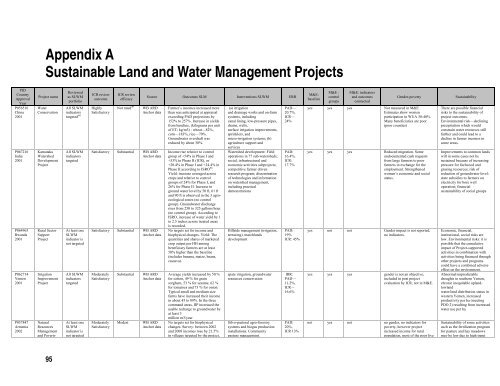Adapting to Climate Change: Assessing the World Bank Group ...
Adapting to Climate Change: Assessing the World Bank Group ...
Adapting to Climate Change: Assessing the World Bank Group ...
You also want an ePaper? Increase the reach of your titles
YUMPU automatically turns print PDFs into web optimized ePapers that Google loves.
Appendix ASustainable Land and Water Management ProjectsPIDCountryApprovalYearP056516China2001P067216India2001P064965Rwanda2001P062714Yemen2001P057847Armenia2002Project nameWaterConservationKarnatakaWatershedDevelopmentProjectRural Sec<strong>to</strong>rSupportProjectIrrigationImprovementProjectNaturalResourcesManagementand PovertyReviewedas SLWMportfolioAll SLWMindica<strong>to</strong>rstargeted 48All SLWMindica<strong>to</strong>rstargetedAt least oneSLWMindica<strong>to</strong>r isnot targetedAll SLWMindica<strong>to</strong>rstargetedAt least oneSLWMindica<strong>to</strong>r isnot targetedICR reviewoutcomeHighlySatisfac<strong>to</strong>ryICR reviewefficacyNot rated 49Source Outcomes SLM Interventions SLWM ERRWB ARDAnchor dataSatisfac<strong>to</strong>ry Substantial WB ARDAnchor dataSatisfac<strong>to</strong>ry Substantial WB ARDAnchor dataModeratelySatisfac<strong>to</strong>ryModeratelySatisfac<strong>to</strong>rySubstantialModestWB ARDAnchor dataWB ARDAnchor dataFarmer’s incomes increased morethan was anticipated at appraisalexceeding PAD projections by152% <strong>to</strong> 257%. Increase in yieldsfrom baseline, (kilograms per uni<strong>to</strong>f ET; kg/m3) : wheat—82%,corn—183%, rice—70%.Groundwater overdraft wasreduced by about 30%.Income rise relative <strong>to</strong> controlgroup of +54% in Phase I and+53% in Phase II (ICR), or+20.4% in Phase I and +24.4% inPhase II according <strong>to</strong> ISRO 50 .Yield: increase averaged acrosscrops and relative <strong>to</strong> controlgroups of 24% for Phase I, and26% for Phase II. Increase inground water level by 50 ft, 61 ftand 90 ft is observed in <strong>the</strong> 3 agroecologicalzones (no controlgroup). Groundwater dischargerises from 250 <strong>to</strong> 325 gallons/hour(no control group). According <strong>to</strong>ISRO, increase of water yield by 1<strong>to</strong> 2.5 inches across treated areasis recorded.No targets set for income andbiophysical changes. Yield: Thequantities and shares of marketedcrop output per HH amongbeneficiary farmers are at least50% higher than <strong>the</strong> baseline(includes banana, maize, beans,cassava).Average yields increased by 50 %for cot<strong>to</strong>n, 49 % for grainsorghum, 53 % for sesame, 62 %for <strong>to</strong>ma<strong>to</strong>es and 73 % for onion.Typical small and medium sizefarms have increased <strong>the</strong>ir incomein about 45 <strong>to</strong> 89%. In <strong>the</strong> threecommand areas, IIP increased <strong>the</strong>usable recharge <strong>to</strong> groundwater byat least 3million m3/yearNo targets set for biophysicalchanges. Survey: between 2002and 2008 incomes rose by 21.5%in villages targeted by <strong>the</strong> project,(a) irrigationand drainage works and on-farmsystems, includingcanal lining, low-pressure pipes,drains, wells,surface irrigation improvements,sprinklers, andmicro-irrigation systems; (b)agriculture support andservicesWatershed development: Fieldoperations in 77 sub-watersheds;social, infrastructural andeconomic activities subprojects;competitive farmer drivenresearch program; disseminationof technologies and informationon watershed management,including practicaldemonstrationsHillside management (irrigation,terracing), marchlandsdevelopmentspate irrigation, groundwaterresources conservationSilvo-pas<strong>to</strong>ral agro-forestrysystems and biogas productioninstallations. Communitypasture management.PAD—20.7%,ICR—24%PAD:16.4%,ICR:17.7%PAD:19%ICR: 45%IRR:PAD—11.2%,ICR—16.6%PAD:20%,ICR 13%M&E:baselineM&E :controlgroupsM&E: indica<strong>to</strong>rsand outcomesconnectedGender-povertyyes yes yes Not measured in M&E.Estimates show womenparticipation in WUA 30-40%.Many beneficiaries are poor(poor counties)yes yes yes Reduced migration. Someundocumented cash requestsfrom large farmers <strong>to</strong> poorfarmers in exchange for <strong>the</strong>employment. Streng<strong>the</strong>nedwomen’s economic and socialstatus.yes not not Gender impact is not reported,no indica<strong>to</strong>rs.yes yes yes gender is not an objective,included in post projectevaluation by ICR, not in M&E.not yes not no gender, no indica<strong>to</strong>rs forpoverty, however projectincreased income for ruralpopulation, most of <strong>the</strong> poor liveSustainabilityThere are possible financialrisks <strong>to</strong> <strong>the</strong> sustainability ofproject outcomes.Environmental risk—decliningprecipitation which wouldconstrain water resources stillfur<strong>the</strong>r and could lead <strong>to</strong> adecline in farmer incomes insome areas.Improvements <strong>to</strong> common landswill in some cases not besustained because of increasingpressure for fuelwood andgrazing resources; risk ofreduction of groundwater level:state subsidies <strong>to</strong> farmers onelectricity for bore welloperation; financialsustainability of social groupsEconomic, financial,institutional, social risks arelow. Environmental risks: it ispossible that <strong>the</strong> cumulativeimpact of Project-supportedactivities in combination withactivities being financed througho<strong>the</strong>r projects and programscould have a combined adverseeffect on <strong>the</strong> environment.Abnormal/unpredictabledroughts in sou<strong>the</strong>rn Yemen,chronic inequitable uplandlowlandwater/land distribution status inwestern Yemen, increasedproductivity per ha (meetingPDO 2) resulting from increasedwater use per haSustainability of some activitiessuch as <strong>the</strong> fertilization programfor pasture and hay meadowsmay be low due <strong>to</strong> high input95

















